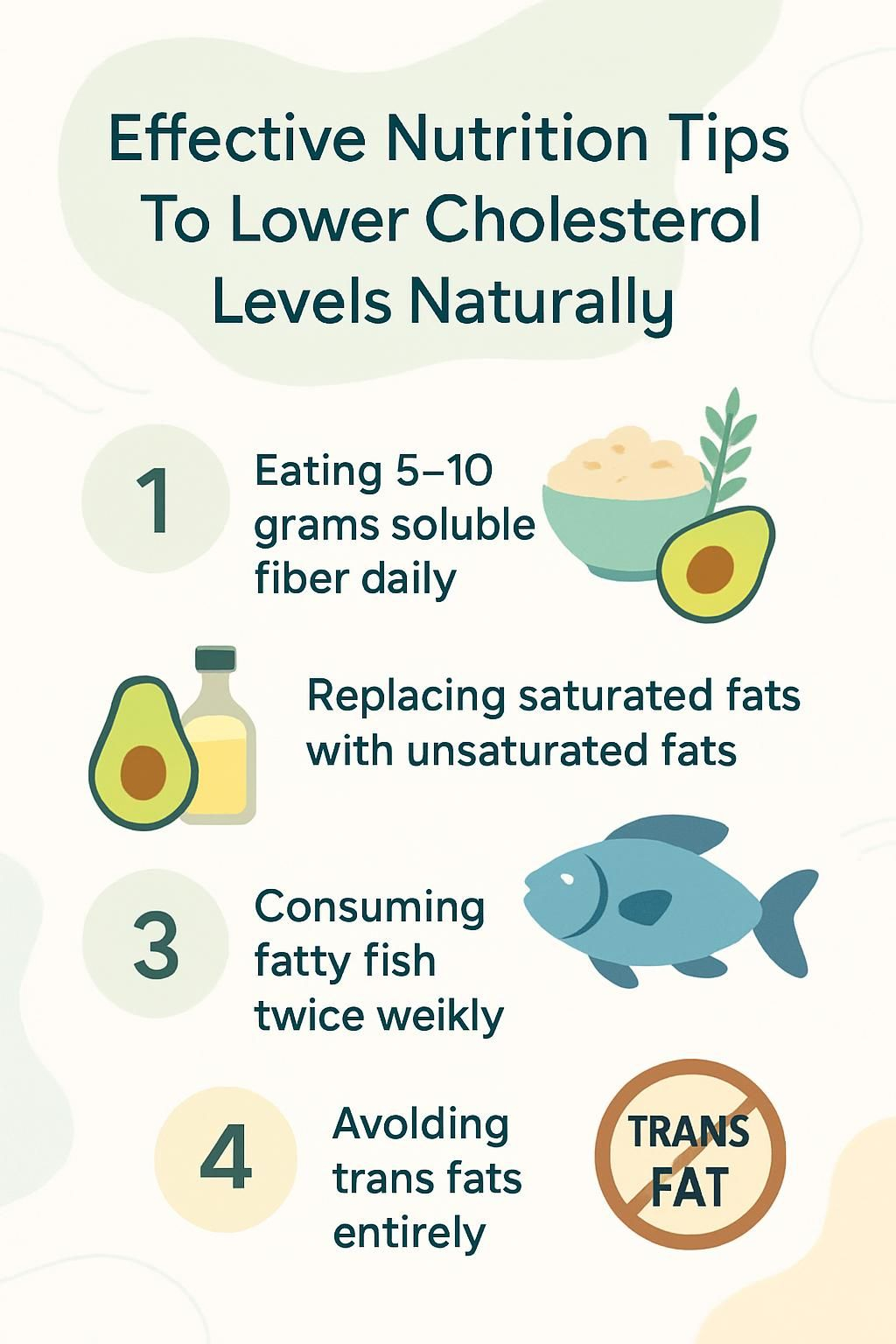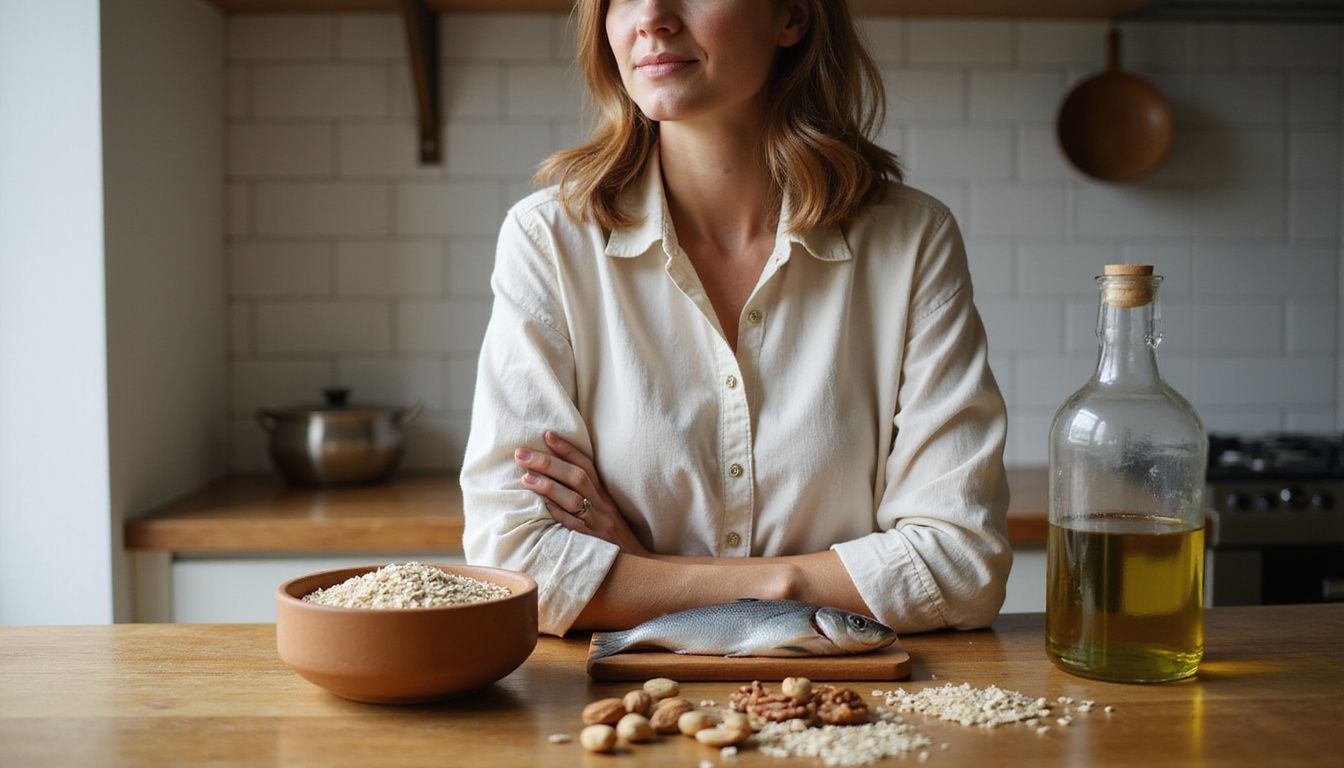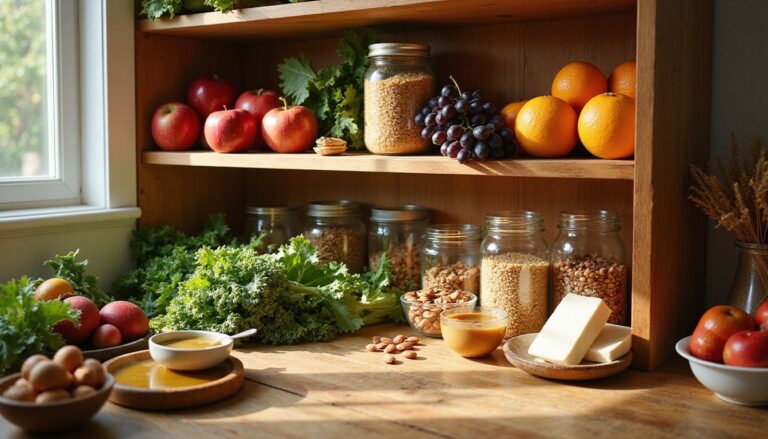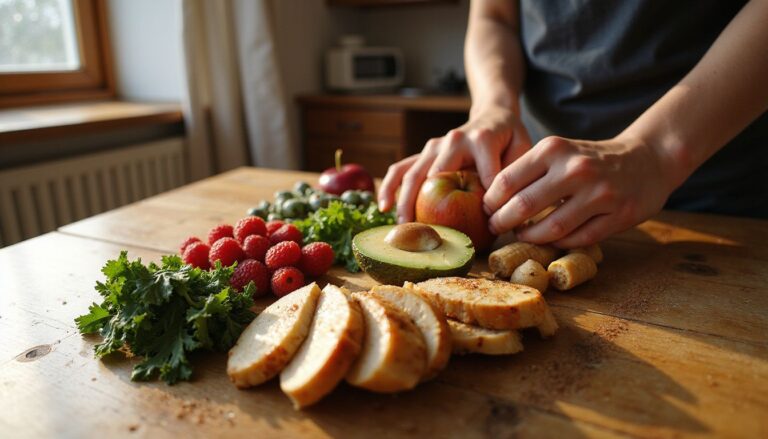Effective Nutrition Tips To Lower Cholesterol Levels Naturally
Our Nutrition Assistant AI Suite will transform your body. You will lose fat, get toned, and build muscle. Gain confidence and optimal health.
If high cholesterol has you worried, you are not alone. Food choices can powerfully lower cholesterol and support heart health. Simple changes help reduce LDL cholesterol, the type that raises risk.
In the next few minutes, you will see how everyday foods, such as oatmeal, beans, nuts, and olive oil, work together to improve your numbers. You will also learn which fats to choose, how to handle sugar, and ways to cook for better heart health.
Start with one small switch this week. Momentum builds fast when meals and habits pull in the same direction.
Key Takeaways
- Getting 5 to 10 grams of soluble fiber each day from oats, beans, and fruit can lower LDL by up to 10 percent (National Institutes of Health).
- Replacing saturated fat from red meat and butter with olive oil, avocados, and nuts may cut LDL by 8 to 10 percent.
- Eating fatty fish like salmon or mackerel two times weekly supplies omega-3 fats that lower triglycerides and support HDL.
- Avoid trans fat, often listed as partially hydrogenated oil, since as little as 2 grams per day raises heart disease risk by 23 percent.
- Limiting added sugar, especially sweet drinks, helps control triglycerides and weight, two keys for heart health.

Understanding Cholesterol Basics

Think of cholesterol as a building block your body makes and uses. Too much in the blood can collect in arteries, which raises the risk of a heart attack or stroke.
What is cholesterol and why does it matter?
Your liver makes cholesterol, a waxy substance used to build cells, make hormones, and produce bile acids for digestion. The body makes all it needs, so dietary cholesterol is optional.
Cholesterol travels in the blood inside particles called lipoproteins. When levels rise too high, fatty buildup can narrow blood vessels and limit blood flow.
The American Heart Association notes that diet affects about 20 to 30 percent of blood cholesterol, while genetics and lifestyle also play strong roles. The National Heart, Lung, and Blood Institute advises routine checks since levels often rise with age.
High blood cholesterol raises the risk of heart disease, the leading cause of death in the United States.
What is the difference between LDL and HDL cholesterol?
LDL is often called bad cholesterol because it delivers cholesterol to tissues. High LDL levels lead to plaque buildup in arteries, which raises the risk of coronary artery disease.
HDL is known as good cholesterol. It carries extra cholesterol back to the liver so the body can remove it. Higher HDL is linked with lower risk.
Saturated and trans fats raise LDL. Foods like butter, fatty red meat, and full-fat dairy tend to push LDL upward. Omega-3 rich fish, regular activity, and weight management support healthier HDL levels.
Targets many clinicians use: keep LDL under 100 mg/dL, and HDL above 40 mg/dL for men or 50 mg/dL for women. Even a modest 10 percent drop in LDL can reduce heart attack risk by nearly 20 percent (NIH).
During one checkup, I swapped chips for a small handful of walnuts most afternoons. Over a few months, my LDL improved, and my HDL nudged higher.
How does cholesterol function in the body?
Cholesterol helps form cell membranes, supports hormone production, and assists digestion. The liver both makes cholesterol and clears extra amounts from the blood.
The body uses cholesterol to make bile acids that break down fat during digestion. Soluble fiber from oats and beans can bind bile, which helps remove cholesterol from the body.
Plant sterols and stanols from nuts and vegetable oils can block cholesterol absorption in the gut. Diet, age, and genes all shape your cholesterol balance.
How Diet Affects Cholesterol Levels
Food is one of the clearest levers you can pull to improve blood lipids. Small daily choices add up over time.
How does food impact cholesterol levels?
Meals high in saturated fat, such as fatty beef, cheese, and full-fat dairy, raise LDL. Trans fats in processed foods raise LDL and lower HDL, a double hit.
Cutting saturated fat to less than 7 percent of daily calories can lower LDL by up to 10 percent, according to scientific reviews. Adding soluble fiber from oatmeal, legumes, fruits, and vegetables helps block cholesterol absorption.
Choosing plant proteins like beans and lentils trims saturated fat while adding fiber. Balanced plates that include whole grains, colorful produce, lean proteins, and healthy oils support heart health.
Which foods should I eat or avoid to manage cholesterol?
The right mix of foods can lower LDL while protecting HDL. Research from systematic review and meta-analysis studies highlights these steps:
- Eat oats, oat bran, beans, whole grains, apples, pears, and citrus. Soluble fiber in these foods lowers LDL cholesterol.
- Include salmon, sardines, or mackerel twice per week. Omega-3 fats reduce triglycerides and may support lower blood pressure.
- Choose nuts like almonds and walnuts for snacks. Meta-analyses of randomized controlled trials show LDL improvements.
- Use olive or avocado oil instead of butter or coconut oil. Healthy unsaturated fats support lower LDL.
- Add legumes and soy protein to meals. Reviews of randomized trials show improvements in cholesterol and blood pressure.
- Pick low-fat or nonfat dairy. Full-fat dairy raises saturated fat intake and raises LDL over time.
- Avoid trans fats in commercial baked goods, processed snacks, and items listing partially hydrogenated oils.
- Limit sugary drinks. Excess sugar raises triglycerides and can lower HDL.
- Reduce processed meats like hot dogs, bacon, and sausage. These raise saturated fat intake and heart risk.
I traded my afternoon candy bar for walnuts after a lab review. Six months later, my LDL dropped by 12 points without medicine.
Season with herbs and citrus instead of extra salt. Food stays flavorful while supporting heart health.
Foods That Help Lower Cholesterol Naturally
Build your low-cholesterol diet around fiber-rich plants, healthy fats, and omega-3 seafood. These choices make daily progress easier.
How do oatmeal, oat bran, and high-fiber foods help cholesterol?
Oats and other high-fiber foods provide soluble fiber that traps cholesterol in the gut. Eating 5 to 10 grams of soluble fiber per day can lower LDL.
A single bowl of oatmeal or oat bran cereal supplies about 3 to 4 grams. Add fruit like berries or a sliced banana to increase the total. Barley and certain cereals also offer helpful fiber.
Psyllium husk, about 2 teaspoons per day, adds roughly 4 grams of soluble fiber. Most people fall short on fiber, so aim for 20 to 35 grams daily, with at least 5 to 10 from soluble fiber.
When I switched my usual breakfast to oatmeal with fruit, my cholesterol panel improved within three months.
Why are omega-3 rich fish good for cholesterol?
Fatty fish, including salmon, trout, herring, mackerel, and tuna, contain omega-3 fats. These lower triglycerides and support HDL levels.
Enjoy fish two or three times each week as part of a heart-healthy plan. Replacing saturated fat with omega-3 rich foods often improves blood lipids.
Plant sources like walnuts, ground flaxseed, and canola oil add more omega-3s. The Food and Drug Administration supports eating fish regularly for heart benefits.
Ask your clinician before starting fish oil supplements, especially if you take blood thinners.
Can almonds, walnuts, and other nuts lower cholesterol?
Yes. Eating about 2 ounces of nuts per day may lower LDL by around 5 percent. Walnuts contain omega-3s, while almonds provide fiber and plant protein.
Use a small handful as a snack, sprinkle over salads, or add to oatmeal. Nuts are calorie dense, so keep portions modest. Skip sugary glazes and heavy coatings.
I keep a small jar of mixed nuts at my desk. It helps me avoid the vending machine.
What heart-healthy fats do avocados provide?
Avocados supply monounsaturated fats, often called MUFAs, which help lower LDL and may raise HDL. They also provide fiber that supports healthy cholesterol levels.
Research published in 2022 linked two servings of avocado per week with lower heart disease risk. Swap avocado for mayonnaise or cheese on sandwiches to cut saturated fat.
Choose fresh avocado over heavy dips to keep calories and saturated fat in check.
How does olive oil benefit cholesterol levels?
Replacing butter or lard with olive oil lowers saturated fat in your meals. Extra-virgin olive oil, a core part of the Mediterranean diet, is associated with better cholesterol profiles and lower heart attack risk.
Use up to 4 tablespoons per day for cooking, roasting, or salad dressings. The unsaturated fats in olive oil help keep arteries clear and support nutrient absorption from vegetables.
What are plant sterols and stanols, and how do they help?
Plant sterols and stanols are compounds found in nuts, seeds, and some vegetables. They block cholesterol absorption in the gut, which reduces LDL.
Foods fortified with sterols or stanols, such as certain spreads and orange juice, can lower LDL by 5 to 15 percent when you get about 2 grams per day. Evidence supports LDL lowering, though reducing heart events needs more study.
Use these products alongside fiber-rich foods, legumes, and healthy fats for a stronger effect.
How do legumes and beans improve cholesterol?
Beans and lentils are rich in soluble fiber, which binds cholesterol in the digestive tract. This process lowers LDL without reducing HDL.
Eating at least one half cup of beans daily adds meaningful fiber that supports heart health. Replacing higher-fat meats with bean-based dishes can also help manage weight and blood pressure.
Clinical studies show legumes lower LDL and triglycerides, two important markers tied to heart risk.
Which fruits and vegetables support cholesterol health?
Apples, pears, citrus fruits, and Brussels sprouts provide soluble fiber that binds bile acids. Less cholesterol then enters your bloodstream.
Pectin, a form of soluble fiber found in apples, grapes, strawberries, and citrus, supports healthy cholesterol levels. Eggplant and okra are low-calorie options that add more soluble fiber.
Produce also supplies antioxidants that protect heart cells. Aim for several servings daily since most people fall short.
Foods to Avoid or Limit for Better Cholesterol Levels
Choosing what to skip can be as powerful as what you add. A few limits protect progress.
Why limit saturated fats from red meat and dairy?
Saturated fat from red meat, butter, cheese, and full-fat dairy raises total and LDL cholesterol. Processed meats, such as bacon and sausage, add extra risk.
Health experts suggest keeping saturated fat under 7 percent of daily calories. Many people see an 8 to 10 percent drop in LDL with this change.
Coconut and palm oils are high in saturated fat even though they sound plant based. Swapping in olive or sunflower oil helped my cooking stay flavorful while my cholesterol improved.
Choose lean cuts, bake or grill more often, and use low-fat or nonfat dairy to reduce saturated fat.
How do trans fats in processed foods affect cholesterol?
Trans fats raise LDL and lower HDL. They often appear in commercial baked goods, some fast foods, and items listing partially hydrogenated oils.
Even 2 grams per day can raise heart disease risk by 23 percent. The FDA acted to remove partially hydrogenated oils from the food supply, but small amounts may still appear in imported or older products.
Read labels closely and choose whole foods when possible.
Summary:
- Trans fats increase LDL and reduce HDL.
- They hide in baked goods, fried foods, and processed sauces under different names.
- Avoid them completely to protect your heart.
What is the impact of excess sugar and sugary drinks?
Added sugar pushes up triglycerides, which raises heart risk. Sweet drinks are an easy way to exceed your limits.
Processed snacks and desserts often swap out fat for sugar. Choose whole fruit instead of juice to get fiber without a sugar surge.
I began tracking added sugar for two weeks and switched to homemade snacks. Cravings faded, and my energy felt steadier.
If you have diabetes or high blood sugar, ask your clinician about safe targets. Cutting sugary drinks helps cholesterol, triglycerides, and weight control.
Should I avoid high-cholesterol foods like organ meats and shellfish?
Organ meats and shellfish are high in dietary cholesterol. Eggs also contain cholesterol. For most people, saturated and trans fats are stronger drivers of LDL than dietary cholesterol itself.
Small portions of these foods can fit into a balanced plan if your overall saturated fat intake remains low. People with heart disease or very high LDL may need stricter limits, so check with a healthcare professional.
Tracking my meals showed the biggest improvements came from eating more plants and less red meat, not from avoiding shrimp.
Cooking Tips to Lower Cholesterol
Good cooking methods turn smart ingredients into heart-friendly meals. Flavor does not need extra saturated fat.
Which cooking oils are best for lowering cholesterol?
Use canola, sunflower, safflower, or extra-virgin olive oil in place of butter, lard, or shortening. These oils are high in unsaturated fats that lower LDL and support HDL.
Studies link up to 4 tablespoons of extra-virgin olive oil daily with fewer heart attacks. Sauté vegetables, roast potatoes, or whisk dressings with olive oil and vinegar.
Avoid coconut and palm oils due to high saturated fat. I swapped butter for olive oil in baking, and my recipes still tasted great while my numbers improved.
How can baking, grilling, or steaming help reduce cholesterol?
Baking, grilling, and steaming use less oil and reduce added saturated fat. Grilling lets fat drip away, while steaming keeps vegetables tender without heavy sauces.
Remove chicken skin before cooking, and chill soups to skim solid fat. I moved from frying to baking chicken, and within six months my cholesterol panel improved.
Double the vegetables in soups and stews to raise fiber and cut calories per serving.
How do herbs and spices replace salt for healthier cooking?
Season with garlic, onions, black pepper, citrus zest, and fresh herbs to keep sodium low. Basil, oregano, thyme, and rosemary brighten soups and main dishes without salty blends.
Make your own spice mixes to avoid hidden salt and preservatives. Many herbs and spices supply antioxidants that support heart health.
I made a quick stir-fry with ginger, turmeric, red pepper flakes, and cilantro. The flavor popped, and I did not miss the salt.
Why choose low-fat or non-fat dairy products?
Low-fat or nonfat dairy lowers saturated fat and calories compared with full-fat options. That change helps reduce LDL.
Greek yogurt and reduced-fat cheese provide taste and texture with less saturated fat. Unsweetened soy, oat, or almond milk can be good choices for many recipes.
Read labels and use these products in cereals, sauces, and casseroles to keep meals balanced.
Sample Meal Ideas for a Cholesterol-Lowering Diet
Use these simple ideas to make healthy eating routine. Prep ahead so good choices are easy on busy days.
What are some healthy breakfast options to lower cholesterol?
Start with oatmeal or oat bran topped with berries and a small handful of nuts. Aim for 3 to 4 grams of fiber from the cereal alone.
Plain Greek yogurt with fruit and seeds offers protein and calcium without excess saturated fat. Skip sugary cereals and pastries, which raise triglycerides.
What makes a good lunch for cholesterol control?
Build a salad with grilled chicken or fish and olive oil dressing. Add tomatoes, peppers, carrots, and spinach for fiber and antioxidants.
Lentil soup with whole-grain bread delivers plant protein and soluble fiber. Avoid processed meats and limit full-fat cheese. Chickpeas or beans make salads more filling and support lower LDL.
Which dinners support cholesterol lowering?
Baked salmon with steamed vegetables provides omega-3 fats and key nutrients. Aim for at least 8 ounces of fish each week.
Try a vegetable stir-fry with tofu, a handful of nuts, and brown rice or barley. Choose baking, steaming, or grilling to reduce added fats. Double the vegetables to boost fiber.
Flavor with spices, citrus, and herbs instead of butter or cream sauces.
What are smart snack choices for cholesterol health?
Pick snacks with fiber, healthy fats, and protein. Good options include a quarter cup of nuts or seeds, fruit with a few nuts, or roasted chickpeas.
Three cups of plain popcorn with a stick of reduced-fat string cheese offers whole grains and calcium. Raw vegetables with hummus provide crunch and fiber.
Plain Greek yogurt with a half cup of whole-grain cereal can be filling. Celery with unsweetened nut butter also works well.
Skip processed snacks high in trans fat, sodium, or added sugar. Many low-fat products hide extra sugar that does not help cholesterol goals.
Lifestyle Tips to Complement a Healthy Diet
Food is the foundation, yet daily habits make progress stick. Small routines help your numbers trend in the right direction.
How does portion control affect cholesterol?
Portion control helps manage weight, which lowers LDL and improves heart health. Losing 5 to 10 percent of body weight can reduce LDL meaningfully.
Fill plates with vegetables, whole grains, lean protein, and healthy fats in modest amounts. Use measuring cups or visual cues to guide portions.
Nuts are heart healthy but calorie dense, so keep servings small. Ask your clinician about calorie needs that fit your age, size, and activity level.
Why is hydration important for cholesterol management?
Good hydration supports blood flow and digestion, which helps the body move and remove cholesterol. Water also helps fiber do its job in the gut.
Choose water, herbal tea, or sparkling water instead of sweet drinks to avoid sugar spikes and extra calories. Keep alcohol modest to protect progress on triglycerides and weight.
How much alcohol is safe when managing cholesterol?
Too much alcohol makes the liver produce more cholesterol. Most experts suggest up to one drink per day for women and up to two for men.
One drink equals 12 ounces of beer, 5 ounces of wine, or 1.5 ounces of spirits. Drinking more raises triglycerides and blood pressure.
Choose seltzer, tea, or water more often, especially alongside meals rich in vegetables, whole grains, beans, fish, and nuts.
What types of physical activity help lower cholesterol?
Aerobic activity such as brisk walking, cycling, swimming, or jogging can raise HDL and improve overall lipid levels. Aim for at least 150 minutes per week at a moderate pace.
Strength training reduces body fat and builds muscle, which helps your body handle cholesterol better. Bodyweight moves or resistance bands work well.
Fold movement into daily life. Take the stairs, park farther away, or do short activity breaks throughout the day.
Popular Diet Plans for Lowering Cholesterol
Structured plans can make healthy eating easier. Two well-studied options support lower LDL and better heart health.
What is the Mediterranean diet and how does it help?
The Mediterranean diet focuses on fruits, vegetables, whole grains, beans, nuts, olive oil, and regular fish. This pattern lowers LDL and supports higher HDL.
Cooking with extra-virgin olive oil instead of butter is a key habit. Research links this approach with fewer heart attacks and better long-term health.
How does the TLC diet support cholesterol reduction?
The Therapeutic Lifestyle Changes, or TLC, diet limits saturated fat to less than 7 percent of daily calories and encourages more soluble fiber. Oatmeal, beans, and whole grains play a central role.
Snacking on nuts, using olive oil or avocado, and eating omega-3 rich fish twice weekly round out the plan. Some foods are fortified with plant sterols or stanols, which can help block cholesterol absorption.
When Diet Changes Aren’t Enough
Sometimes genes or other factors keep LDL high despite strong effort. That is when medical guidance matters most.
When should I see a healthcare professional about cholesterol?
See a clinician if your numbers stay high after steady diet and lifestyle changes. Some people have genetic conditions like familial hypercholesterolemia, which make LDL harder to control with food alone.
Regular blood tests, usually every one to two years, track progress and guide next steps. Your clinician can build a personal plan that may include medicine.
What medications and treatments are available for high cholesterol?
Statins are the most common drugs for lowering LDL. They block a liver enzyme used to make cholesterol. Other options include bile acid sequestrants, ezetimibe, PCSK9 inhibitors, and niacin.
People with familial hypercholesterolemia or very high LDL often need medicine in addition to diet and exercise. As we age, cholesterol can rise, so treatment sometimes changes over time.
In my fifties, heart-healthy meals improved my panel, but I still needed a statin. The combination worked better than either step alone.
Conclusion
Healthier meals and daily habits can lower cholesterol in practical, lasting ways. Focus on soluble fiber, plant-forward plates, healthy fats like olive oil, regular fish, and portion control. Limit saturated fat, trans fat, and added sugar.
Many people thrive on the Mediterranean diet or the TLC diet. If changes do not move your LDL cholesterol enough, talk with your clinician about next steps. This information is educational and not a substitute for medical advice.
Each smart choice helps protect your heart. Start today, and let small wins carry you forward.
FAQs
1. What foods should I include in my diet to help lower cholesterol levels naturally?
Eating more fruits, vegetables, and whole grains can support healthy cholesterol levels. Adding nuts such as almonds or walnuts to your daily dish also helps reduce bad cholesterol according to research from the American Heart Association.
2. How do nuts (fruit) affect cholesterol management?
Nuts like pistachios and hazelnuts are rich in unsaturated fats that improve blood lipid profiles. Studies show that eating a small handful of these nut fruits each day may lower LDL (bad) cholesterol by up to 10 percent while keeping HDL (good) cholesterol stable.
3. Are there specific dishes (food) recommended for lowering high cholesterol?
Dishes featuring oats, beans, lentils, and leafy greens provide soluble fiber which binds with excess cholesterol in the digestive tract. For example, oatmeal topped with berries or a bean salad makes an effective meal choice for heart health.
4. Can changing my nutrition alone significantly impact my cholesterol numbers?
Research supports that dietary changes play a key role in managing blood lipids; however, results vary based on individual factors such as genetics and activity level. In my experience working with patients who adopted plant-based diets rich in nut fruit snacks and balanced dishes containing legumes saw measurable improvements within three months.
Summary: A diet focused on nutrient-rich foods including nut fruits and wholesome dishes can contribute meaningfully to natural reductions in unhealthy blood lipids when combined with other lifestyle adjustments supported by scientific evidence.







